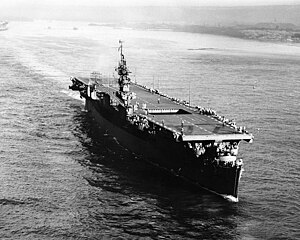 USS Belleau Wood December 1943
| |
| History | |
|---|---|
| Name | Belleau Wood |
| Namesake | Battle of Belleau Wood |
| Builder | New York Shipbuilding Corporation |
| Laid down | 11 August 1941 |
| Launched | 6 December 1942 |
| Commissioned | 31 March 1943 |
| Decommissioned | 13 January 1947 |
| Stricken | 1 October 1960 |
| Honors and awards | |
| Fate | Sold for scrapping 21 November 1960 |
| Name | Bois Belleau |
| Commissioned | 23 December 1953 |
| Decommissioned | 12 December 1960 |
| Fate | Returned to US, September 1960 |
| General characteristics | |
| Class and type | Independence-class aircraft carrier |
| Displacement | Full load: 14,751 long tons (14,988 t) |
| Length | 622 feet 6 inches (189.74 m) |
| Beam | 71 ft 6 in (21.79 m) (waterline) |
| Draft | 24 ft 3 in (7.39 m) |
| Installed power |
|
| Propulsion |
|
| Speed | 31.6 kn (58.5 km/h; 36.4 mph) |
| Complement | 1,569 officers and men |
| Armament | |
| Aircraft carried |
|
USS Belleau Wood was a United States Navy Independence-class light aircraft carrier active during World War II in the Pacific Theater from 1943 to 1945. The Independence class were ordered as light cruisers of the Cleveland class, but during construction, they were converted into light carriers owing to the need for additional vessels of that type during the war. The ship was originally named New Haven, but was renamed Belleau Wood after conversion work had begun, after the Battle of Belleau Wood of World War I.
Belleau Wood saw extensive action during World War II, participating in the Gilbert and Marshall Islands campaigns in late 1943 and early 1944, and the Mariana and Palau Islands campaign in mid-1944. There, she saw action at the Battle of the Philippine Sea, where her aircraft contributed to the sinking of the Japanese carrier Hiyō. She fought in the Philippines campaign later that year, and saw action at the Battle of Leyte Gulf. Shortly thereafter, she was damaged by a kamikaze. After repairs, she supported the invasion of Iwo Jima in March 1945 and operations against the Japanese Home Islands. After the war, she participated in Operation Magic Carpet missions before being placed in reserve in 1947.
The ship was loaned to the French Marine Nationale in the 1950s and served in the First Indochina War. During this period, she was renamed Bois Belleau, the French equivalent of her original name. The ship was returned to the United States in 1960, but was not retained in US Navy service; she was instead broken up for scrap that same year.